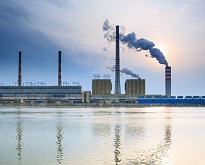
Several air pollutants contribute to the acidification of the environment. The most important ones are the gases sulphur dioxide (SO2), nitrogen oxides (NOX) and ammonia (NH3). Their impact can be observed in the progressive degradation of soils, water and forests. They also contribute to the formation of fine particles in the air that cause respiratory diseases. The acidifying potential of these pollutants is commonly measured in SO2 equivalents.
Between 2008 and 2016, the total emissions of acidifying gases emitted by European Union (EU) businesses and households decreased by 6.3 million tonnes of SO2 equivalents, which represents a reduction of 26 %. Over this period, emissions of sulphur dioxide fell by 55 %, nitrogen oxides by 25 %, and ammonia by 1 %.
Agriculture, forestry and fishing contributed 43 % of the total acidifying gas emissions in 2016 (mostly ammonia), while transportation and storage accounted for 20 % (mostly nitrogen oxides) and manufacturing 11 %.
The electricity, gas, steam and air conditioning supply industry contributed 10 % towards total acidifying gas emissions in 2016. Since 2008 there has been a drop of 2.6 million tonnes of SO2 equivalents in this sector, due to the more systematic use of end-of-pipe pollution filters, and the introduction of more efficient combustion technology in the electricity and heat production.
Households accounted for 10 % of the total emissions of acidifying gases in 2016 (predominantly nitrogen oxides).
The source data set is here.
Note:
The data presented in this news item are based on Eurostat's air emissions accounts, which follow the so-called residence principle. There are two internationally established approaches to reporting air emissions:
- The above mentioned air emissions accounts (AEA) produced by Eurostat under Regulation (EU) No 691/2011 on European environmental economic accounts; and
- National inventories for greenhouse gases and other air pollutants compiled and published by the European Environment Agency (EEA).
National and EU totals differ between the two approaches, as different boundaries apply.
For more information:
- Statistics Explained article on air pollution statistics – air emissions accounts
- Overview of environmental statistics and accounts
To contact us: estat-user-support@ec.europa.eu

